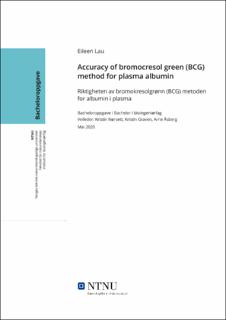| dc.description.abstract | Albuminkonsentrasjon kan måles ved bruk av flere metoder, så som bromokresolgrønn metode og immunefelometrisk metode. Resultater målt ved forskjellige metoder kan variere til en viss grad, spesielt ved lavere albuminkonsentrasjon. Det er dermed viktig å vite hvor mye det skiller seg fra immunefelometrisk- (referanse) metoden. Målet med denne studien var å undersøke og vurdere albuminkonsentrasjoner målt ved bromokresolgrønn metode (AlbBCG) og immunefelometrisk metode (AlbNEPH).
Totalt 204 anonyme pasientprøver ble valgt tilfeldig og målt i 2 analyseinstrumenter. Advia Chemistry XPT bruker BCG-metoden, mens Atellica NEPH 630 anvender immunefelometrisk metode i albuminanalysen. Andre parametere som alder, kjønn og kreatininkonsentrasjoner ble notert. Statistisk analyse ble utført ved å bruke MedCalc for å analysere sammenheng mellom variablene og regresjonsanalyse.
Gjennomsnittet av AlbBCG og AlbNEPH var signifikant forskjellig basert på t-test analysen. Det var også en sterk korrelasjon (r = 0,944, p <0,0001) mellom begge metodene. Passing-Bablok regresjonsmodell og Bland-Altman-analyse viste at det var en systematisk feil som førte til en forskjell mellom AlbBCG og AlbNEPH. Ytterligere undersøkelser ved bruk av multippel lineær regresjon viste at det var en lineær sammenheng med god korrelasjon (r = 0,59, p <0,0001) mellom forskjellen mellom AlbBCG og AlbNEPH og gjennomsnittet av begge metodene. Forskjell på AlbBCG og AlbNEPH skyldtes muligens overvurderingen av AlbBCG som ga positiv middelforskjell. Med en slik forskjell i albuminresultatene, er det viktig å evaluere de forskjellige albuminmålingsmetodene som brukes i laboratorier. | |
| dc.description.abstract | Albumin concentration can be measured using several methods such as bromocresol green method and immunonephelometric method. Results measured by different methods may vary to some extent especially at lower albumin concentration. It is thus important to know how much it is differed from the immunonephelometric (reference) method. The aim of this study is to investigate and assess albumin concentrations measured by bromocresol green method (AlbBCG) and immunonephelometric method (AlbNEPH).
A total of 204 anonymous patient samples were selected randomly and measured in 2 analytical instruments. Advia Chemistry XPT applies BCG method while Atellica NEPH 630 applies immunonephelometric method in the albumin analysis. Other parameters such as age, gender and creatinine concentrations were noted. Statistical analysis was performed by using MedCalc to analyse correlation between the variables and regression analysis.
The mean of AlbBCG and AlbNEPH was significantly different based on the t-test analysis. There was also a strong correlation (r = 0.944, p<0.0001) between both methods. Passing-Bablok regression model and Bland-Altman analysis showed that there was a systematic error which led to a difference of AlbBCG and AlbNEPH. Further investigations using multiple linear regression showed that there was a linear relationship with good correlation (r = 0.59, p<0.0001) between difference of AlbBCG and AlbNEPH and mean of both methods. There was no correlation between age, gender, creatinine concentration and difference of AlbBCG and AlbNEPH. Difference of AlbBCG and AlbNEPH was possibly due to the overestimation by AlbBCG which produced positive mean difference. With the difference in the albumin results, it is important to evaluate the different albumin measurement methods used in laboratories. | |
